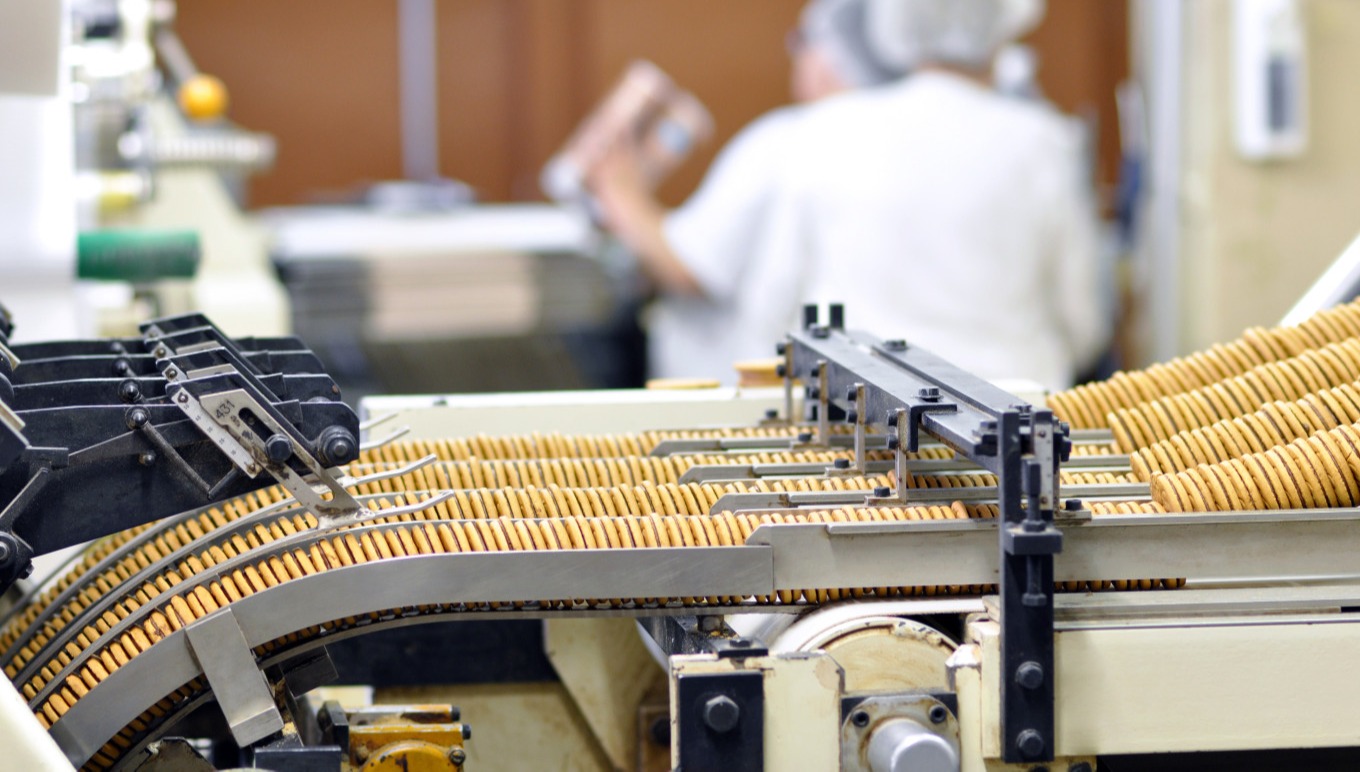Uitgelicht in deze blog
Hoe u risico's op voedselterugroepacties en traceerbaarheid in uw organisatie kunt verminderen
Hoe u risico's op voedselterugroepacties en traceerbaarheid in uw organisatie kunt verminderen
Blog
Belangrijkste inzichten
Deze blog belicht de belangrijkste risico's rond voedselterugroepacties en traceerbaarheid, en hoe ERP- en PLM-systemen helpen deze te verminderen.
Voorkom allergenenbesmetting met behulp van receptbeheer, allergenentracking, bi-directionele traceerbaarheid en door ERP ondersteunde training van medewerkers.
Voorkom fouten in etikettering en verpakking door ERP-geïntegreerde etikettering, PLM-verpakkingsworkflows, barcodescanning en digitale goedkeuringen.
Handhaaf consistente hygiënepraktijken met behulp van ERP-gestuurde inspectiestatussen, taakherinneringen en realtime hygiënedocumentatie.
Stop kruisbesmetting op oppervlakken via gedocumenteerde schoonmaak-SOP's, geautomatiseerde reiniginsschema's en digitale verantwoordingsfuncties in ERP.
Kies voor een holistische aanpak met Aptean Food and Beverage ERP voor volledige zichtbaarheid, naleving van regelgeving, schaalbaarheid inde cloud en AI-gestuurde risicobewaking.

Stel u voor dat u in uw favoriete mueslireep bijt- en ineens op een stukje plastic kauwt. Dat is niet alleen een bedorven snack; het is een reputatiecrisis in wording. En het gebeurt vaker dan u denkt. Volgens FSNS werden in 2024 maar liefst 296 voedselterugroepacties uitgevoerd – goed voor miljoenen aan verloren product, rechtzaken, geschokt consumentenvertrouwen en onherstelbare merkschade. Vraag het maar aan de merken achter recente, opvallen terugroepacties; één fout is genoeg om de verkeerde redenen in de krantenkoppen te belanden.
Het waarborgen van voedseltraceerbaarheid lijkt misschien een verplicht vinkje op een checklist, maar het is uw eerste verdedigingslinie tegen rampscenario's. U kunt zich niet veroorloven te gissen waar een ingrediënt vandaan kwam of in paniek te zoeken naar besmette batches wanneer uw producten al in de schappen liggen. Daarom vertrouwen toonaangevende voedingsbedrijven op technologie, zoals speciaal ontwikkelde ERP-systemen voor de voedingsindustrie om het zware werk te doen: elke stap in de reis van uw ingrediënten traceren, risico's vroegtijdig signaleren en terugroepacties eenvoudiger voorbereiden. Wanneer traceerbaarheid in uw processen is ingebouwd, reageert u niet achteraf op problemen – u beschermt uw klanten én uw reputatie in real time.
Allergenenbesmetting
Als u de trends op het gebied van voedselveiligheid volgt, valt één ding direct op: niet-aangegeven allergenen blijven verantwoordelijk voor het grootste deel van de voedselterugroepacties – vorig jaar goed voor maar liefst 34% van alle gevallen. U heeft de krantenkoppen ongetwijfeld voorbij zien komen: koekjes die mogelijk melk of noten bevatten, of paneermeel dat per ongeluk met sesam is verpakt. Voor uw bedrijf kan zelf één enkele fout van dit soort leiden tot kostbare terugroepacties, ernstige gezondheidsrisico's voor consumenten en langdurige schade aan de geloofwaardigheid van uw merk.
Wat dit risico extra uitdagend maakt, is dat de wetgeving rond allergenen etikettering verre van uniform is. In de VS worden negen hoofdallergenen erkend, terwijl het VK en de EU etikettering voor 14 allergenen verplicht stellen. Om in alle markten aan de regels te voldoen én kruisbesmetting op de productievloer te voorkomen, is robuust allergenenbeheer onmisbaar. Productielijnen waarop apparatuur wordt gedeeld tussen verschillende recepturen vergroten deze risico's aanzienlijk. Kortom: het is een regelgevend mijnenveld met hoge inzet – want niet-naleving kan leiden tot boetes, terugroepacties en zelfs verlies van markttoegang.
Hoe allergenen besmetting te voorkomen?
Het beheersen van allergeenrisico's draait om het verankeren van gedisciplineerde protocollen in elke laag van uw organisatie. Aan de frontlinie betekent dit dat u moet standaardiseren hoe uw team met allergenen omgaat. Denk aan het gebruik van apart keukengerei, kleur gecodeerde containers en duidelijk afgebakende opslagzones voor allergene ingrediënten.
Medewerkers moeten echter niet alleen weten wat ze moeten doen, maar ook waarom. Daarom is consequente training essentieel. U kunt er niet op rekenen dat mensen elke regel foutloos toepassen als ze het achterliggende belang niet begrijpen – zeker niet bij nieuwe of tijdelijke krachten. Regelmatige trainingen over allergenen bewustzijn, ondersteund door duidelijke en overal beschikbare visuele aanwijzingen, helpen de kans op kruisbesmetting tijdens drukke diensten drastisch te verkleinen. De echte meerwaarde ontstaat wanneer u fysieke en organisatorische maatregelen combineert met technologische ondersteuning, zoals allergeen beheer en traceerbaarheids functionaliteit binnen gespecialiseerde software. Het juiste ERP-systeem voor de voedingsindustrie kan helpen op manieren die statische checklists simpelweg niet kunnen:
Formule- en receptbeheer met allergenen tracering: Koppel elke grondstof en elk eindproduct aan het bijbehorende allergeen profiel om menselijke fouten te minimaliseren.
Bi-directionele traceerbaarheid: traceer bij een incident direct alle betrokken grondstoffen en eindproducten, zowel achteruit als vooruit in de supply chain.
Productspecificatiemodule: Centraliseer alle informatie over ingrediënten, allergenen en voedingswaarden, met realtime updates en eenvoudige exportmogelijkheden voor naleving van de traceerbaarheidsvoorschriften.
Kortom: met de juiste procedures én de juiste software wordt voedseltraceerbaarheid sneller, nauwkeuriger en veel minder foutgevoelig. In het geval van een terugroepactie kunt u precies bepalen welke batches zijn getroffen, in plaats van een grootschalige, merkschadelijke terugroepactie te riskeren op basis van onvolledige gegevens – en dat versterkt uw voedselveiligheidsstrategie aanzienlijk.
Foutieve etikettering en verpakkingsproblemen
Foutieve etikettering lijkt misschien een beginnersfout, maar het is een van de meest heimelijke bedreigingen voor voedselveiligheid en traceerbaarheid. Wanneer een verkeerd etiket op het verkeerde product belandt, loop u het risico producten te verkopen met niet-aangegeven allergenen, ontbrekende voedingsinformatie of zelfs verlopen ingrediënten. Dit is niet alleen een gezondsheidsrisico – het is ook een nachtmerrie voor uw reputatie en voor de naleving van regelgeving.
Waarom duikt foutieve etikettering toch steeds weer op? Vaak ligt het aan consistente sjablonen, gehaaste productie en handmatige, last-minute correcties. Eén enkele kopieer- of plakfout kan zich door de hele productierun verspreiden, waardoor uw organisatie zowel bij klanten als bij toezichthouders in de problemen komt. Het is het soort eenvoudige misstap die u duur kan komen te staan.
Hoe terugroepacties door foutieve etikettering te voorkomen:
Als u wilt dat voedseletikettering een kracht wordt in plaats van een zwakte, is consistentie essentieel. Begin met het vastleggen van etiketteringssjablonen en het standaardiseren van goedkeuringsworkflows. Elk label moet een gecontroleerd, stapsgewijs proces doorlopen, inclusief digitale goedkeuringsketens, QA-controles en geautomatiseerde printverificatie - geen vrije aanpassingen meer vijf minuten voor aanvang van een dienst.
Barcode-scanning en geautomatiseerde validatieroutines bieden een andere eenvoudige winst. Deze digitale vangrails detecteren verkeerd etiketteerde producten, mismatches en verlopen codes voordat een product de lijn verlaat, waardoor traceerbaarheid wordt verbeterd en het risico op terugroepacties wordt verkleind. Het inzetten van branche gerichte technologie, zoals een ERP-systeem voor voeding of product lifecycle management (PLM)-software, tilt uw verpakking en etikettering naar een hoger niveau en garandeert naleving van regelgeving.
ERP-geïntegreerde etikettering tools: Genereer gedetailleerde, gereguleerde productetiketten en barcodes rechtstreeks vanuit uw ERP, met actuele ingrediënten- en productgegevens, zonder dubbele invoer.
PLM-software verpakkingsontwikkeling: Maak gebruik van ingebouwde berekeningen van voedingswaarden, volledige verpakkingsreviews, volg artwork-revisies en werk samen via speciaal ontwikkelde commentaar- en verificatie tools.
Versiebeheer en goedkeuringsworkflows voor etiketten: Zorg ervoor dat etiketwijzigingen worden gecontroleerd, goedgekeurd en gekoppeld aan de juiste eindproducten, zodat niets door de mazen van het net glipt.
Met geavanceerde branchespecifieke oplossingen profiteert u van snelle traceerbaarheid en gestroomlijnde naleving. Doordat elk ingrediënt- en etiketversie is gekoppeld aan productspecificaties en batchgegevens, kunt u problemen eenvoudiger isoleren en direct actie ondernemen voordat een kleine fout uitgroeit tot een merkcrisis.
Inconsistente hygiënepraktijken
Hygiënefouten in uw organisatie kunnen dagelijks een grote impact hebben op voedselveiligheid en traceerbaarheid. We hebben allemaal de gevolgen wel eens gezien – of het nu gaat om E. coli in uien bij grote fastfoodketens of salmonella op komkommers. Dergelijke uitbraken blijven niet onopgermerkt en worden niet ongestraft gelaten. Ze veroorzaken schokgolven in de sector, terwijl de klantloyaliteit van eht betrokken merk van de ene op de andere dag keldert.
Wat zijn de oorzaken van hygiëneproblemen? Vaak liggen ze in een gebrek aan verantwoording van het personeel en, nog vaker, in een onvoldoende strike monitoring van de omgeving. Overgeslagen reinigingsrondes of korte snellere handwasroutines tijdens drukke diensten geven ziekteverwekkers en vreemde materialen de kans om binnen te dringen. Het resultaat: gevaarlijke producten die kunnen leiden tot kostbare terugroepacties en zelfs juridische gevolgen.
Hoe consequente hygiënenormen te handhaven
Routine trainingen op het gebied van hygiëne en veiligheid zijn niet onderhandelbaar. Maak er een gewoonte van, geen vinkje op je onboardingsformulier. Ondersteun dit met opvallende bewegwijzering in alle werkruimtes, die als visuele herinnering dient voor uw team en iedereen herinnert aan het waarom achter de regels.
Persoonlijke beschermingsmiddelen (PBM) zijn ook van groot belang. Zorg voor verplicht gebruik van PBM en ondersteun dit met steekproeven. Wanneer medewerkers zien dat hygiëne- en PBM-regels consequent worden nageleefd, stijgt de norm. Het geeft een duidelijke boodschap af: “We hechten waarde aan voedselveiligheid omdat we waarde hechten aan u – en aan onze klanten.”
Zo kan een ERP-systeem voor de voedingsindustrie ervoor zorgen dat hygiëne daadwerkelijk wordt nageleefd:
Geavanceerde commentaarmodule: Voeg hygiëne-instructies, herinneringen of speciale vereisten toe aan specifieke productlijnen of productieorders, zichtbaar in realtime.
Inspectiestatusfuncties: Ken inspectiestatussen toe aan partijen en batches waardoor goederen die niet voldoen aan de vereiste hygiëneprotocollen worden geblokkeerd. Alerts waarschuwen uw personeel wanneer controles actie vereisen.
Workflowgestuurde taakherinneringen: Pas inspecties en opmerkingen aan zodat uw medewerkers precies op het juiste moment de juiste taken uitvoeren, zoals “ontsmet voor gebruik.”
Met deze maatregelen die op de achtergrond draaien, krijgt uw organisatie de mogelijkheid om hygiëne in elke fase te documenteren, te monitoren en af te dwingen. Dit niveau van controle gaat veel verder dan wat handmatige logboeken ooit kunnen bieden, waardoor voedselveiligheid en traceerbaarheid een routineonderdeel van uw voedingsbedrijf worden – en niet slechts een rapport achteraf.
Vervuiling van het oppervlak
Wanneer u meerdere productielijnen beheert, kunnen gedeelde oppervlakken en apparatuur uw zwakste schakel in voedselveiligheid zijn. Kruisbesmetting van oppervlakken ontstaat wanneer apparatuur, gereedschappen of zelfs werkkleding allergenen of ziekteverwekkers van het ene product naar het andere overbrengen. Dit is vooral risicovol in bedrijven met een allergenendivers portfolio – denk aan noten in het ene uur, zuivel in het volgende.
Hoewel u misschien denkt dat uw schoonmaakroutines op orde zijn, is de realiteit dat over het hoofd geziene oppervlakken, vergeten keukengerei of snelle spoeling gevaarlijke resten kunnen achterlaten. Eén enkel incident kan leiden tot een grootschalige terugroepactie, waardoor het traceren van getroffen ingrediënten en het uitvoeren van een terugroepacties een echte uitdaging wordt voor uw team en uw partners in de supply chain.
Kruisbesmetting voorkomen met sanitaire protocollen
Preventie begint met standaard operationele procedures (SOP's) voor reiniging en hygiëne. Leg in duidelijke taal vast wat, wanneer en hoe schoonmaak plaatsvindt tijdens elke productierun. Vertrouw niet op “zo doen we het altijd” - documenteer de details en werk ze bij naarmate uw processen evolueren.
Training is essentieel. Zorg ervoor dat uw medewerkers precies weten hoe ze oppervlakken moeten roteren en apparatuur tussen batches moeten ontsmetten. Regelmatige opfristrainingen voorkomen shortcuts en maken duidelijk dat het overslaan van een stap niet zomaar een kleine fout is, maar een recept voor grootschalige terugroepacties.
Zo kan een speciaal ontwikkeld ERP-systeem voor voeding en dranken schoonmaaktaken automatiseren en verifiëren:
Geautomatiseerde planning van schoonmaaktaken: Wijs schoonmaakrotaties toe aan teams of ploegen met behulp van aangepaste digitale checklists.
Aangepaste statussen: Stel bijvoorbeeld de status 'Ontsmetting nodig' in. Het ERP-systeem vraagt medewerkers om deze schoonmaaktaak te voltooien voordat ze een nieuw product voorbereiden – overslaan is niet toegestaan.
Verantwoording via inspectiemodule: Bouw verantwoordingsstappen in met audittrails en digitale handtekeningen, zodat elke ontsmettings actie wordt geregistreerd en traceerbaar is.
Digitale verantwoording zorgt voor een hogere nauwkeurigheid en eenvoudigere audits. U hoeft nooit te twijfelen of de juiste reiniging heeft plaatsgevonden – uw traceerbaarheidsspoor laat een digitale footprint achter van elke actie en sluit zo de cirkel rond besmettingsrisico's.
Holistische verbetering van voedselveiligheid met Aptean
U heef nu gezien hoe risico's voor voedselterugroepacties en traceerbaarheid – van allergenen tot foutieve etikettering, hygiënegaten en kruisbesmetting – kunnen leiden tot negatieve krantenkoppen, operationele chaos en aanzienlijke schaduw aan uw merk. Dit zijn echte uitdagingen waarmee uw organisatie dagelijks te maken heeft. Het goede nieuws is dat u met een proactieve aanpak en de juiste digitale partner risicogebieden kunt omzetten in concurrentievoordelen.
Maak kennis met Aptean. Onze bekroonde ERP-systemen voor de voedings- en drankenindustrie zetten voedselveiligheid, traceerbaarheid in de supply chain en risicobeheer voorop. Van bidirectionele tracking van ingrediënten en producten tot robuuste allergenencontrole, wij zorgen ervoor dat u volledig inzicht en controle krijgt over elk product, ingrediënt en batch.
Onze branchespecifieke Aptean Food and Beverage ERP gaat verder dan de basis. Het systeem koppelt naadloos met uw andere bedrijfssoftware (van klantrelatiebeheer tot transporttools), zodat u datasilo's eenvoudig kunt doorbreken. Cloudhosting biedt continu, schaalbaar toegang, waar uw team ook werkt, met beveiliginscontroles van wereldklasse. Upgrades en systeemonderhoud worden op afstand verzorgd, zodat u zich kunt concentreren op voedselveiligheid en niet op IT-problemen.
Om uw concurrentievoordeel nog verder uit te breiden, biedt ons AppCentral-platform een alles-in-één oplossing met AI, die kant-en-klare koppelingen tussen uw Aptean-applicaties levert om end-to-end processen te stroomlijnen en datasilo's te elimineren. AppCentral bevat ook innovatieve AI-functionaliteiten voor voorspellende inzichten, geautomatiseerde workflows, eenvoudige installatie en intelligente asisstentie via chat in natuurlijke taal.
Klaar om uw processen voor voedselveiligheids en terugroepacties te upgraden? Neem vandaag nog contact met ons op of maak gebruik van onze producttour om te ontdekken hoe food ERP uw risicobeheer kan transformeren en voedseltraceerbaarheid uw grootste troef kan maken.
Vergroot de traceerbaarheid in uw bedrijf
Bent u klaar om uw voedings- en drankenbedrijf naar een hoger niveau te tillen? Dan helpen we u graag.



 Jack Payne | Vice President, Product Management & Solutions Consulting
Jack Payne | Vice President, Product Management & Solutions Consulting